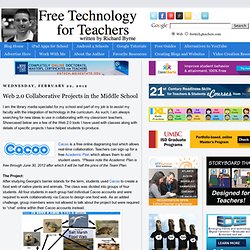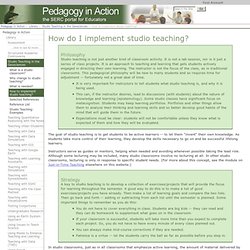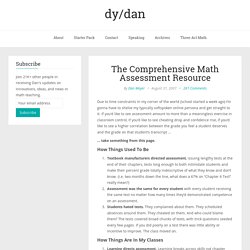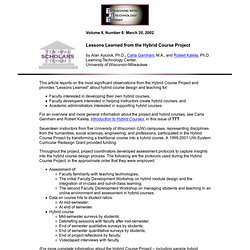

Web 2.0 Collaborative Projects in the Middle School. I am the library media specialist for my school and part of my job is to assist my faculty with the integration of technology in the curriculum.

As such, I am always searching for new ideas to use in collaborating with my classroom teachers. Showcased below are a few of the Web 2.0 tools I have used with classes along with details of specific projects I have helped students to produce. Cacoo is a free online diagraming tool which allows real-time collaboration. Teachers can sign up for a free Academic Plan which allows them to add student users. *Please note the Academic Plan is free through June 30, 2012 after which it will be half the price of the Team Plan.The Project: After studying Georgia's barrier islands for the term, students used Cacoo to create a food web of native plants and animals. My Observations: Teaching the kids how to use the program took half a class period as students caught on very quickly. Clayton Christensen Institute for Disruptive Innovation. How to implement studio teaching? Philosophy Studio teaching is not just another kind of classroom activity.

It is not a lab session, nor is it just a series of class projects. It is an approach to teaching and learning that gets students actively engaged in directing their own learning. The instructor is not the focus of the class, as in traditional classrooms. SCALE-UP Site. The Comprehensive Math Assessment Resource. Due to time constraints in my corner of the world (school started a week ago) I’m gonna have to shelve my typically softspoken online persona and get straight to it.

If you’d like to see assessment amount to more than a meaningless exercise in classroom control, if you’d like to see cheating drop and confidence rise, if you’d like to see a higher correlation between the grade you feel a student deserves and the grade on that student’s transcript … … take something from this page. How Things Used To Be Textbook manufacturers directed assessment, issuing lengthy tests at the end of their chapters, tests long enough to both intimidate students and make their percent grade totally indescriptive of what they know and don’t know. (i.e. two months down the line, what does a 67% on “Chapter 6 Test” really mean?)
View Message - Re: Hybrid Courses. Podcast217: Making the Case for Blended Learning. <div class="greet_block wpgb_cornered"><div class="greet_text"><div class="greet_image"><a href=" rel="nofollow"><img src=" alt="WP Greet Box icon"/></a></div>Hello there!

If you are new here, you might want to <a href=" rel="nofollow"><strong>subscribe to the RSS feed</strong></a> for updates on this topic. <div style="clear:both"></div></div></div> This podcast is a recording of a thirty minute skype connection I made to GT teachers in Ector County Schools, Odessa, Texas, on January 18, 2008.
The focus of my presentation was making the case for using and supporting blended learning tools and learning methodologies in the 21st century classroom. SBG. Teaching with Technology Today: Volume 8, Number 6. This article reports on the most significant observations from the Hybrid Course Project and provides "Lessons Learned" about hybrid course design and teaching for: For an overview and more general information about the project and hybrid courses, see Carla Garnham and Robert Kaleta, Introduction to Hybrid Courses, in this issue of TTT.

Seventeen instructors from five University of Wisconsin (UW) campuses, representing disciplines from the humanities, social sciences, engineering, and professions, participated in the Hybrid Course Project by transforming a traditional course into a hybrid course. A 1999-2001 UW-System Curricular Redesign Grant provided funding. Throughout the project, project coordinators developed assessment protocols to capture insights into the hybrid course design process. The following are the protocols used during the Hybrid Course Project, in the approximate order that they were employed:
Hybrid Courses: Faculty Resources. Advantages.

Blended Learning at GrayHarriman.com. Science Daily: News & Articles in Science, Health, Environment & Technology. MeTA musings. Chemistry. Blended Learning in K-12. MIT + K12. Teaching with Technology Today, Volume 8, Number 6.
What is a hybrid course?

Hybrid courses are courses in which a significant portion of the learning activities have been moved online, and time traditionally spent in the classroom is reduced but not eliminated. The goal of hybrid courses is to join the best features of in-class teaching with the best features of online learning to promote active independent learning and reduce class seat time. Using computer-based technologies, instructors use the hybrid model to redesign some lecture or lab content into new online learning activities, such as case studies, tutorials, self-testing exercises, simulations, and online group collaborations.
What is the Hybrid Course Project? During 1999-2001, the University of Wisconsin System Curricular Redesign Grant Program funded a collaborative project involving UW-Milwaukee and four UW-College campuses (Rock County, Sheboygan, Washington, and Waukesha).